The pineapple people of Northland
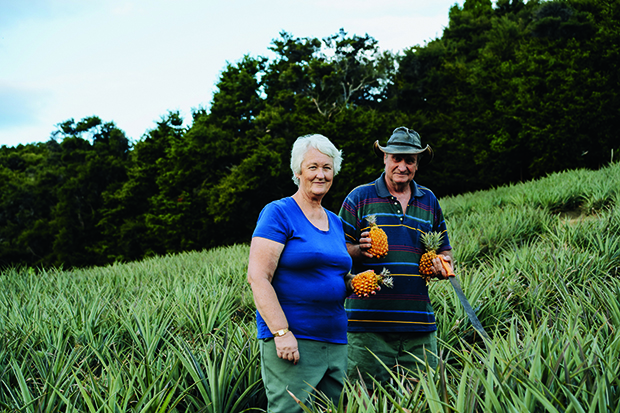
Linda and Owen Schafli of Geneva Fruits holding their queen pineapples. They expect to harvest 20,000 this year.
With a few hand tools and a love of growing, a Northland family has created a thriving plantation and sowed the seeds for a burgeoning community.
Words: Michael Andrew Photos: Jess Burges
Who: Owen, Linda and Colin Schafli
What: Geneva Fruits, tropical fruit estate. 6.8 hectares (16.8 acres)
Where: Parua Bay, 30 minutes east of Whangārei
Facebook: Geneva Fruits
They’ve heard of him in the restaurants. They’ve heard of him at the markets. They’ve heard of him wherever his produce is sold. The Northland locals who’ve met him know him as Owen. But to others, he is simply the man behind the pineapples.
Owen Schafli’s pineapple operation in Parua Bay is something of an icon in Northland, where tropical fruit is fast becoming a viable enterprise. With the bare minimum of machinery and resources, he, his wife Linda and son Colin managed to transform a scraggy, clay-soil bush block into New Zealand’s first commercial pineapple plantation, Geneva Fruits. Last summer they harvested 6,000 pineapples. This summer they’re expecting 20,000. Marketed as “the best pineapples you’ll ever taste”, the fruit sells out at the Whangārei Growers Market every Saturday, and this year the Schaflis will make a profit for the first time in their eight-year venture.
Owen sums up his achievements with textbook modesty.
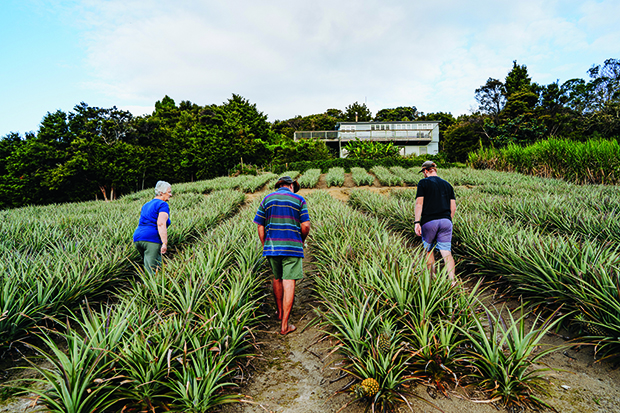
The Schafli family inspect their crop.
“I do my best with what I can,” he says. “I just carry on doing my best, and I get results. It’s been quite a journey.”
Owen is an expert in “carrying on”, often in spite of the raised eyebrows of those around him. In 2011, when the Schaflis lived in Hamilton, he told his church group he was moving his family up north for a life of farming – they thought he was mad. After he bought his ramshackle bush block with a half-finished house on it and began growing tropical fruit, others thought he was dreaming. But Owen has a habit of defying doubters. Not only has he had success with pineapples, but he’s managed to grow coffee, papaya, prickly pears, bananas and passionfruit, all of which are thriving on his apparently unremarkable block in an unlikely corner of Northland.
“I’m also experimenting with a couple of tropical pawpaw, and I think it’s going to be successful,” he says. “All my friends are growing them in hothouses, but I’m going to prove we can grow them outdoors.”
It may seem like the result of dogged determination, but Owen’s success has a lot to do with the growing experience he developed in his homeland, South Africa, where pineapples are grown widely.
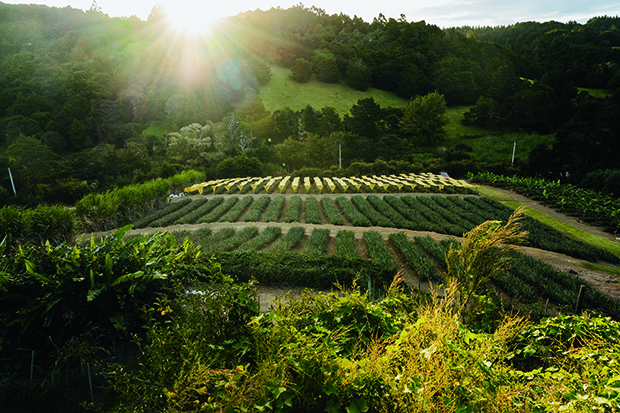
The pineapples are planted in rows on gently sloping ground.
“I realised back in South Africa there were some cold areas where pineapples did really well. So they can endure frost. They’re part of the bromeliad family, which can do well here in Whangārei, so we thought ‘well, let’s do it’.”
But doing it was far more complicated than it sounds. With gorse, scrub and covenanted bush entangling their 6.8-hectare property, the Schaflis worked tirelessly to prepare the land, first by restoring the rundown farmhouse and then by clearing pockets of scrub to establish the first of their tropical fruit: bananas. While bananas grow widely across Northland, few people, if any, had managed to produce a commercial yield. Yet the Schaflis managed to establish several banana species as cash crops, and on higher ground they trialled queen pineapples they got from a friend in Kaeo.
“I chose the queen because I grew them in South Africa,” Owen says. “They’re sweet and delicious and multiply easily. I started with about 400 a year in the beginning, and they just multiplied.”
Multiplying them, however, was an exercise in patience.
OWEN’S METHOD
In its first flowering cycle, a pineapple plant flowers only once and produces a single pineapple, which can take up to three years to mature from the time of the initial planting. But while the fruit develops, the plant grows suckers in the leaves beneath, which will themselves bear fruit after the first pineapple is harvested.
Owen’s method involved regularly stripping the original plants of their suckers and replanting them in rows, where they would eventually produce their own fruit. Some of the four-year-old plants now have four or five pineapples on them.
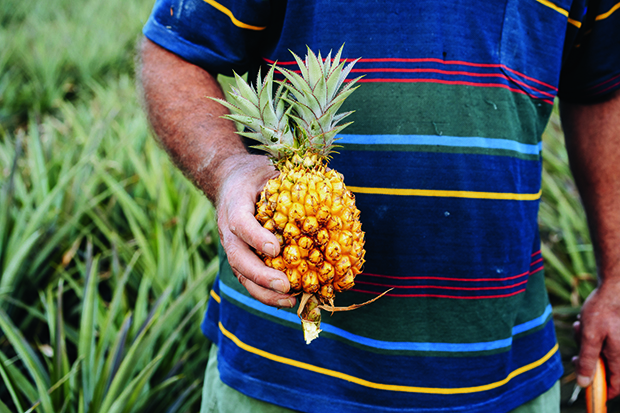
“To prepare the land for pineapples, we rotovated the soil, then from there everything was done by hand or with a hoe and scoop.”
He says growing pineapples is a long, laborious process – not suitable for anyone looking to make a quick profit.
“It has been a little bit intensive – all the planting I’ve done myself. My back has been good, I had a few niggles, but I think all the planting has made it stronger. My son started helping out from last July. Basically this is a family business now.”
Prior to Owen’s exploits, the prevailing wisdom decreed that the Northland climate, although subtropical, was too cold for outdoor pineapples, which would surely perish in the first winter frost.
But Owen developed unique systems to ensure his crops remained healthy and viable. He planted sugarcane shelterbelts, which grew exceptionally quickly and provided a kind of natural greenhouse, insulating the pineapples from the chill. Pineapples are a dryland crop, and the Northland rainfall has been sufficient enough that the Schaflis have not needed to irrigate.
Pineapples also “don’t like wet feet,” Owen says. They were therefore planted on sloping land so water would drain away without rotting the roots.
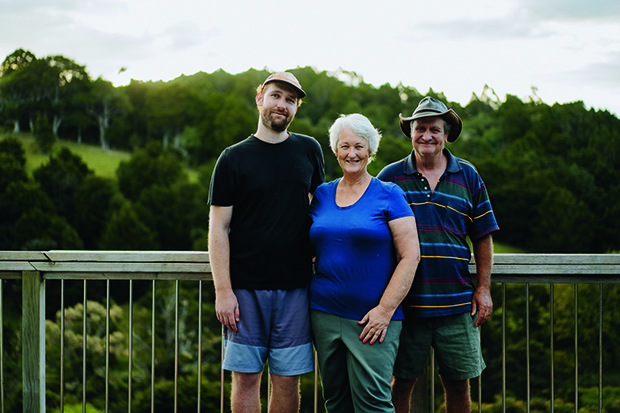
Colin, Linda and Owen Schafli.
The Schaflis use a potassium nitrate and ammonium sulphate fertiliser mix, but Owen is coy with the details, wanting to keep the formula secret.
But one of the most important discoveries was how poorly the pineapples do when forced to compete with other plants. At the outset, Owen’s growing site was overrun with kikuyu: a tenacious African creeping grass that grows in northern and coastal New Zealand, and smothers tropical crops.
“The secret to growing pineapples is they don’t like competition, they don’t do well at all. I had to spray the kikuyu to kill it, and glyphosate is the best to sort it out. It takes one to two years, and then by the time you’re planting pineapples the kikuyu doesn’t come up again. Once the pineapples are planted, any weeds are removed with a push hoe or by hand.”
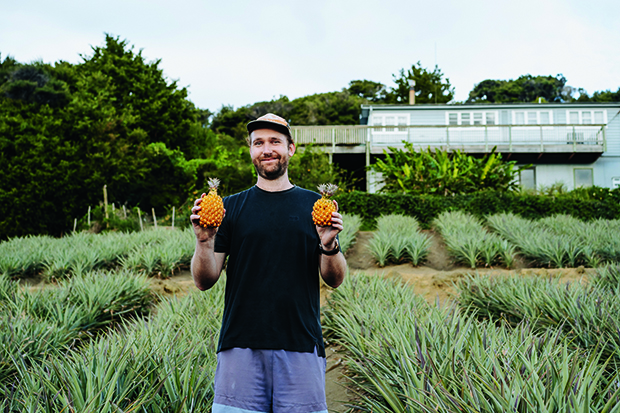
Colin Schafli holding queen pineapples.
This of course means the pineapples aren’t organic. However, Owen says the fruit itself is spray free. It’s also free of ethephon, a plant growth regulator that some overseas pineapple producers spray on their crops to promote synchronous fruiting within a six-week window. “I’m not using that hormone,” Owen says. “I seem to have them bearing fruit all year-round.
From the end of March right through to December I’ll be flat out with pineapples.”
THE BANANA BUG
In 2015, Owen met a man named Hugh Rose, who lived with his wife Pauline on a Parua Bay property close to Geneva Fruits. Like many Northlanders, Hugh and Pauline were familiar with growing backyard bananas and had considerable success producing small yet satisfactory fruit. Then they saw Owen’s banana crop, and everything changed.
“I was getting good bananas, but nothing like he produced,” Hugh says. “When I saw what Owen was achieving, I asked him, ‘will you share your knowledge?’ And he did. Within a week I had a hundred of his plants.”
In exchange for the banana guidance, Hugh offered the use of his tractor so Owen could harrow his paddock and put in his first rows of pineapples. The two became fast friends and in the following years they formed the Tropical Fruit Growers of New Zealand association, which has become a stalwart of Northland’s fledgling banana industry.
Hugh and Pauline eventually moved to a larger property, where they’ve become renowned tropical fruit experts in their own right. Yet Owen’s influence was a key part of their journey, Hugh says.
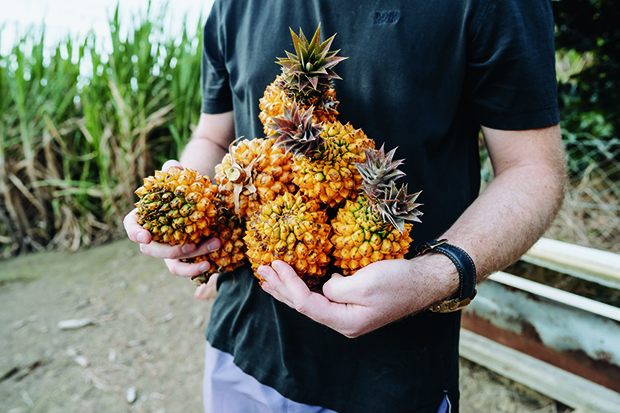
Known for its sweetness, the fruit is sold at the Whangārei Growers Market to great acclaim.
“Owen doesn’t think, he just does! His family in South Africa has been growing tropical fruit for a couple hundred years. As far as he was concerned, the land was not a lot different from where he came from – it just didn’t have any giraffes and elephants walking around. He got those crops established and has gone from strength to strength. I take my hat off to him, he was my inspiration to get into it.”
Owen’s reputation as a trailblazer and mentor does not stop with Hugh. In the Whangārei area, he is regarded as the foremost expert on growing tropical fruit, serving as a “green guru” for aspiring growers and commercial operators alike. Local banana cropper Randal Finlayson purchased Hugh and Pauline’s Parua Bay property after they moved. He soon became an Owen disciple, learning the lore to get the best from the banana crop Hugh had already established. Randal says if anyone in Northland wants to know about growing bananas, they go to Owen.
“He was the instigator of the whole thing,” Randal says. “Bananas have been growing in New Zealand forever, but he’s the one who took it on board to turn it into a commercial operation. He knows everything. He knows every variety. He knows how to get the best out of every tree, how to plant them, where to plant them and how to maintain them. And he’s very helpful to anybody and everyone. All the local growers would have dealt with him to set up their crops.”
With Owen and Hugh as the figureheads, Whangārei’s tropical fruit community has become so collegial that it’s the subject of an upcoming Country Calendar episode, which filmed in autumn 2022 and screened in July of that year.
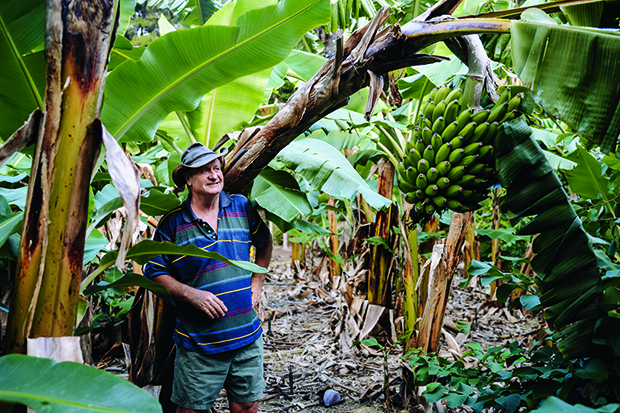
Owen and his family managed to establish several banana species as cash crops.
One of the other growers is Ross Potter, who runs Sunrise Bananas with his wife Karen.
They met Owen in 2018 when they were starting their business. Wanting to learn how to produce the best bananas, they visited Geneva Fruits and Owen shared his knowledge.
“He knows his stuff,” says Ross. “He’s very good with advice and very approachable. You can go and ask him anything.
“The climate is not perfect for growing bananas, but we can do it. As Owen says, ‘we’re all still learning’, and that’s where he’s very good. He doesn’t say he knows everything but he’s set a very good standard for the rest of us to follow.”
‘HELL OF A NICE BLOKE’
While the Schaflis are known throughout the community for their advice and affability, it hasn’t all been plain sailing for the family. Not only did they have the enormous physical challenge of preparing and tending the land, but they did so by relying on Linda’s sole income as a school teacher. The situation became even more precarious when Linda was diagnosed with cancer, forcing her to stop work.
“The family have been through some hard times,” says Randal. “But they’re a good team. They’re very good people. Owen’s a hell of a nice bloke.”
As a fellow grower, Randal is especially impressed with the way in which the Schaflis tamed the property, which is notoriously difficult by most standards. “It’s not like it’s a gently sloping Maungatapere block with volcanic soil. It’s a tough block. It’s clay, it’s full of gorse, and he’s just thrashed it all out.”
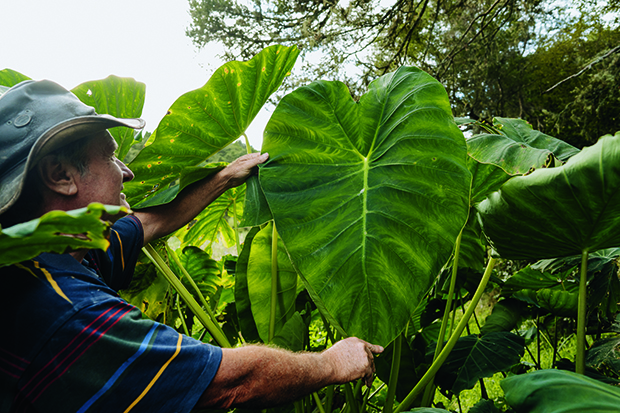
If there’s anything that testifies to the value of the Schaflis’ labours, it’s the quality of the fruit, Randal says.
“Those pineapples he grows – they’re not like the ones that you get imported here which come in green. His ones are so sweet and beautiful. They’re absolutely divine. And I tell ya growing those pineapples is not easy. All that ground he’s dug up by hand, or with a maddock, you know? It’s just incredible. I mean, he must be 70 years old. And he’s always barefoot! They’ve created something really special over there.”
SMALL STEPS AND FAITH
After eight years of tremendous perseverance and physical labour, the Schaflis have effectively created a New Zealand-grown pineapple monopoly, with a dedicated customer base and enquiries coming in from all over the country. And yet, Owen has no intention of putting his feet up and settling with his current crop. His love of growing is far too powerful. In fact, he’s got visions of mass-scale production on his mind.
“I’m a farmer at heart, and I’m asking God for 500 acres,” he declares. When they lived in Hamilton, he packed his 700 square metre property with so much produce he ended up annexing neighbouring sections – with consent, of course. “People thought we were crazy. We grew pumpkins and beans in everybody’s yard, I cut up their lawns.”
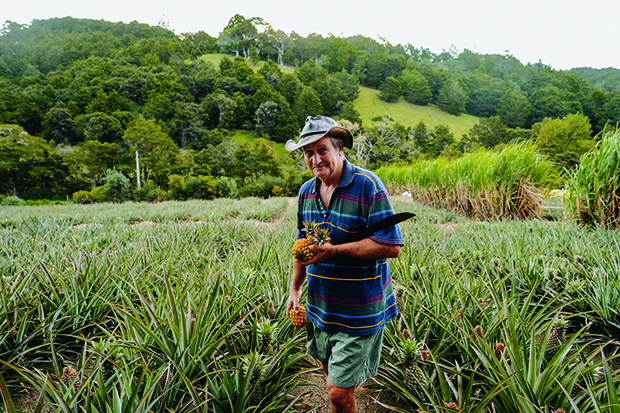
Owen is regarded as Northland’s foremost expert on growing tropical fruit. He’s always happy to share his advice.
His plan for pineapples is just as audacious. Over the next three years, he says he’ll plant every slip and crown that he has and let the suckers multiply.
He’ll then lease more land and plant out five hectares every year for the next six years. “And then I’ll become a really big pineapple farmer! It’s just faith and one step at a time.”
Of course, there’ll be people who’ll raise their eyebrows and huff that it can’t be done. But if Owen’s track record is anything to go by, there’ll be hundreds of acres of pineapple plantations spread out over Northland before the next decade is through. The Schaflis clearly have what it takes to make something like that happen.
Owen’s son Colin sums it up nicely: “Perseverance, enthusiasm, determination and love of the land, are some of the main traits that have helped us grow the best pineapples many people have ever tasted. It’s not always easy, but our belief and hard work has been instrumental in our success. And having faith too.”
HOW TO GROW A PINEAPPLE AT HOME
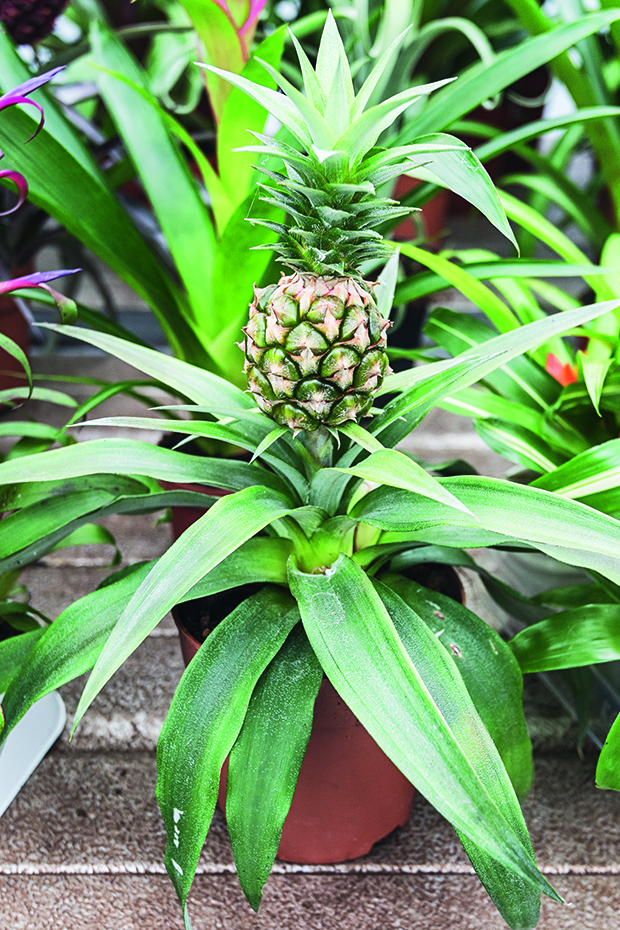
If you live in Northland, you have a good chance of growing a pineapple; certainly not a plantation of them, but at least one you can care for in your backyard. The key is the crown – or the spikey leaves at the top of the pineapple – which can be replanted. In New Zealand, these are removed from imported pineapples due to a biosecurity concern that exotic seeds could be concealed within the leaves. However, the Schaflis’ pineapples have the crowns intact, which is another reason why the fruit is so popular.
Method
1. Remove the crown from a pineapple by cutting or twisting it off.
2. Dry out the crown for several days in a warm sunny area to remove excess moisture.
3. Place the crown in a glass of water or container so that the base is submerged. Leave in full sunlight. Within a few days, roots will have emerged from the bottom of the crown.
4. When the roots are a few centimetres long, replant the crown into a large pot with soil.
5. Move into full sun, water when the soil is dry and try to cover the pot or move it inside during cold spells. Re-plant in a bigger pot when necessary.
6. Wait. Growing pineapples is not a hasty endeavour, and it will take one to three years for your pineapple to produce a single flower and fruit.
Love this story? Subscribe now!
 This article first appeared in NZ Lifestyle Block Magazine.
This article first appeared in NZ Lifestyle Block Magazine.
